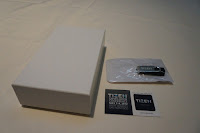I started my second day at the Tizen Conference by having a quite nice breakfast on the morning with some
familiar faces. When enough energy was collected from the provided substances it was time to join to the Ballroom for the first keynote of the day. The first keynote was kept by the members of the Tizen Technical Steering Group members Imad Sousou from Intel and Jong-Deok Choi from Samsung, which was moved to this position from yesterday.
During the keynote there was couple of nice demos shown and some of the tizen features were described. The presentation itself gave very nice picture what is the status of Tizen in the handset type of devices. When the presentation was closing its end the audience got a nice surprise (well, it was sort of told in the registration as well so not really a surprise in the end), which was that every registered attendee would be given a Tizen Developer Device as a giweaway. The device hardware was presented as Dual Core ARM Cortex A9 1.2, 1G of RAM, 16G of Memory, GPS, WiFi, 8mpix camera etc. which was quite nice in the specs.

The device itself looked very much like the devices that the showcase presenters had already shown yesterday and I would guess that the device is the same. Too bad it is a bit bulky design and a bit large thus using it as a everyday device isn't really feasible, which is a bit of lost opportunity in my opinion as there was lot of devices given out for developer that could possibly use the device as everyday device and give much feedback.
After the keynote was over my feelings about Tizen was much more positive and I really was surprised even more that why this presentation was not given as the first one on day 1 as originally scheduled. It would have given much more positive feeling about the Tizen. Only thing that I was really especting in addition to the keynote was QA session with the TSG. Anyway thanks to Imad and Jong-Deok of the nice overview of the Tizen and live demos.
After the TSG it was time for Dr. Nagata from DOCOMO project to give a presentation, which was followed by James Pearce from facebook. After this all the keynotes of the conference were done.
Tech Showcase and lunch followed the series of keynotes and the talks in five different tracks started. I selected which presentations mainly based on my own interest and went to listen the following ones. First Tizen Architecture by Sunil Saxena and Vincent Kwon and as usual with these architecture talks the room was full of people and some of us had to stand.
After the architecture presentation it was time to change room to Bayview. In Bayview I listened to "Engaging Open Source Projects, with a Corporate View" by Thiago Macieira and "Upcoming Technologies: Wayland and oFono" presentations by Jesse Barnes and Marcel Holtmann.
In the beginning of oFono presentation Marcel announced that it has been about 3 years today from the beginning of oFono and they wanted to celebrate their anniversary and cake as well as t-shirts were provided to the audience.
After the Marcel's ~20min presentation about oFono, Jessa talked about Wayland in the same slot, which ended also my visit to the rooms in the "middle floor" and it was time to go back to the Ballroom A again to listen the Orange presentation "Lessons Learnt from Orange in Developing HTML5 Application for Tizen".
When the talk by Orange ended it was time for the evening events and first there were snacks and drinks available in the showroom area where the companies were again showing their work around Tizen. Also another ultrabook lottery was done and one lucky attendee got a brand new device to play with.
After the lottery it was time to move to the buss and towards California Academy of Sciences for the evening event. In the evening event there was food, drinks and live music next to the natural history exhibition and planetarium.


After the evening event it was time for a game of Werewolf hosted by Dawn (thanks for this again) at the hacker lounge.
... and then it was time to start preparing for the third and the last day of the conference....







































